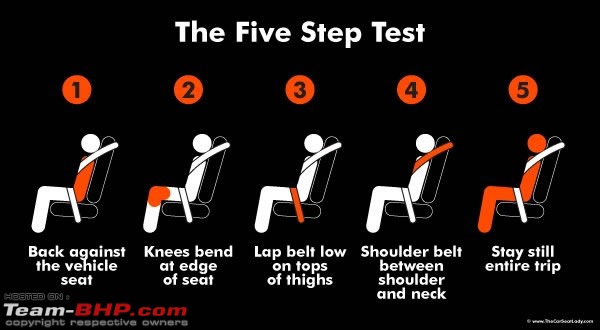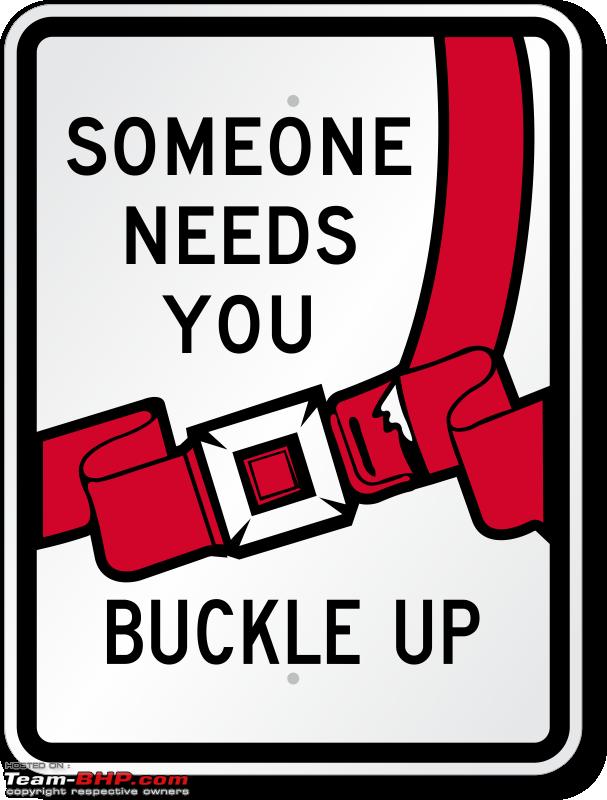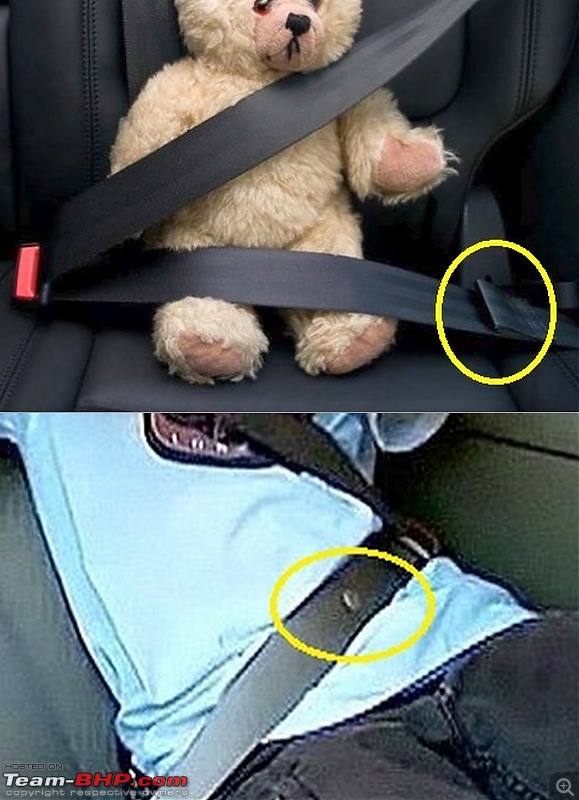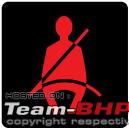Team-BHP
(
https://www.team-bhp.com/forum/)
There are already two edifying threads about seat-belts on how they work and why you should wear them.
How they work? Why you should buckle up?
Article Source:
www.takata.com How seat belts prevent injury?
Seat-belts and child restraints are secondary safety devices and are primarily designed to prevent or minimize injury to a vehicle occupant when a crash has occurred. Seat-belts and child restraints thus:
- Reduce the risk of contact with the interior of the vehicle or reduce the severity of injuries if this occurs;
- Distribute the forces of a crash over the strongest parts of the human body;
- Prevent the occupant from being ejected from the vehicle in an impact;
- Prevent injury to other occupants (for example in a frontal crash, unbelted rear-seated passengers can be catapulted forward and hit other occupants).
- A belted occupant will be kept in their seat and thus will reduce speed at the same rate as the car, so that the mechanical energy to which the body is exposed will be greatly reduced.
Ask me now and I'd say wearing them properly is equally essential!
Yes, If your seat belt is not properly fastened, it will not be effective. In fact, it can be dangerous not to have your seat belt fastened correctly as that might result in seat belt injuries such as sternal, rib fractures and abdominal submarining injury.
Submarining: Sliding of the lap belt above iliac spine due to either bad safety belt geometry or poor coupling of the occupant to the car. This mechanism results in severe abdominal injuries (laceration/perforation of abdominal viscera).
So, lets see how it should be done then.
1. First, sit with your hips and back firmly positioned against the back of the seat. Also, have your seat in an upright position, as much as possible.
Quote:
Key Point!
If you are not sitting firmly in your seat with your hips and back against the seat back, or if the seat is in an overly reclined position you may experience the "submarine effect". This occurs when, during an accident, the body slips below the portion of the belt designed to restrain your hips and back. This may result in serious injuries.
|
2. Grasp and pull the tongue portion and, after confirming the webbing is not twisted, insert it into the buckle portion until you hear or feel the “click."
3. Pull the portion of webbing from the buckle to your shoulder lightly away from your body, and then release it. This will eliminate any slack in the belt.
Quote:
Key Point!
If there is slack in the seat belt between your body and the webbing, there is some potential you may move significantly in the event of a collision. Even though you had your seat belt fastened, your body may still impact other objects in the vehicle, possibly resulting in serious injuries.
|
4. Please check to see whether you have adjusted your seat belt so that the portion designed to restrain your hips and back is low around your waist and is as tight as possible. Also, confirm the portion of the belt crossing over your shoulder passes between the base of your neck and the edge of your shoulder. If not, change the positioning of your seat or use the seat belt height adjuster to correct.
5. The position of the headrest is also important. As a rule of thumb, adjust the height of the headrest so that your temples, which approximates center of gravity of your head, are positioned in the center of the headrest. (Note: In some vehicles, the position of the headrest may not be adjustable)
6. Finally, it is best if the driver can operate the vehicle with no space between the shoulders and the seat. If the driver’s shoulders are not touching the seat, the occupant should either move the seat forward or adjust the seat back to a more upright position.
Finally, take a look at this 5-step quick buckle test before you start rolling.

Buckle up and drive safe lads!

Images: Google and WikiHow
Great thread. Learnt something new - point 3. Did not know that the lap belt (duh) should be on the top portion of the thighs. I always keep it a little bit higher.
- Sam
Quote:
Originally Posted by samaspire
(Post 4072297)
Did not know that the lap belt (duh) should be on the top portion of the thighs. I always keep it a little bit higher.
|
Yes, wearing it over proximal portion of thighs averts the lap belt from slipping over iliac spines thus preventing submarining.
Quote:
Originally Posted by Pferdestarke
(Post 4072318)
Yes, wearing it over proximal portion of thighs averts the lap belt from slipping over iliac spines thus preventing submarining.
|
Ok. I know how to wear the seat belt correctly now.
Side note: I assume you're a doctor, but it will be easier for the readers if you did not use medical terms. :)
Quote:
Originally Posted by Pferdestarke
(Post 4071657)
Buckle up and drive safe lads!
|
Thanks for the thread. Should be very educative for most drivers in India.
I can think of 2 essential bits of information missing from this thread.
1) The use of child seats and booster seats; and
2) How to check whether seatbelts have been deployed in a crash.
For (1), although some detail has been provided, such as this image
Quote:
Originally Posted by Pferdestarke
(Post 4071657)
|
it would be worth going through these videos:
https://www.youtube.com/watch?v=6tCr5unTJFI https://www.youtube.com/watch?v=aWhTPM60Yr8 https://www.youtube.com/watch?v=mjILYVXPc_Q
For (2), look at this picture:

All cars will have such a device - either a button or a stitching - on each seatbelt. In a crash, the seatbelt stretches, and the button pops out, or the stitching is ripped. Once involved in a crash, the seatbelt webbing has been stretched, and will not protect the occupant as effectively as an unstretched belt - and must therefore be compulsorily replaced. Never drive with a seatbelt that has saved one life previously.
The stretch indicator (i.e. the button or stitch) is also an excellent indicator to tell a prospective buyer whether the used car he plans to buy has been involved in a crash and subsequently repaired. No one in this country replaces seatbelts after a crash, however good the workmanship of the repair may be! :)
Quote:
Originally Posted by SS-Traveller
(Post 4072431)
The stretch indicator (i.e. the button or stitch) ...
|
This is an absolutely amazing revelation!
I have been wearing seat belts religiously since before they became a legal requirement in UK. I think it was about forty years ago that I had my little bump on the head that made me think what a
big bump might be like. Yet, I had never heard of this device before.
I guess I subconsciously know that it is there. If I asked, I might say that it is to stop the clip sliding to the bottom. Maybe it does that too. I never knew that it had an important safety function!
Quote:
Originally Posted by samaspire
(Post 4072330)
I assume you're a doctor, but it will be easier for the readers if you did not use medical terms.
|
My bad! That was just a slip of my medical lingo. Since I've already used the term, I guess it's on me to make proper sense of it.
Proximal=Closer to center of body
Quote:
Originally Posted by SS-Traveller
(Post 4072431)
The stretch indicator (i.e. the button or stitch) is also an excellent indicator to tell a prospective buyer whether the used car he plans to buy has been involved in a crash and subsequently repaired.
|
Thanks for your valuable input. Now I get what those buttons on seat belt webbing are intended for. I used to think, they are a sort of reinforcement or something. :uncontrol
Quote:
Originally Posted by SS-Traveller
(Post 4072431)
2) How to check whether seatbelts have been deployed in a crash.
|
Would love to see a picture of a 'popped' button, and an explanation of how it is supposed to work. Esp. pics from cars involved in accidents, where one knows the occupants were wearing seatbelts.
Regards
Sutripta
Thank you for the informative thread.
Seat belts are life savers and to be made mandatory on all class of vehicles.
Usually, people do not use seat belts in commercial vehicles, public transport, taxis etc and even in pvt vehicles, only front seat occupants wear seat belts. Majority of back seat travelers do not wear them.
I refer to the first post wherein the below image shows that the bottom part of the seat belt is to be worn on the thigh part.
Generally the bottom part wraps around your waist and ends behind your hips / back side (marked in yellow in the image). This is the case with all the cars owned/traveled by me.
I guess it is safer to be worn on thighs rather than on hips, but how can this be achieved. Any inputs on this!!
Which cars / manufacturers follow this design principle?
Hello
Many Thanks for this thread !Got some nice information; especially about the pop up button/stitches.
Also the video with the kid “max” wearing the belt helped me gain some brownie points with my kid after showing that to him.
Thanks again!
How do we check if the belt has loosened over the time. My alto is 7 years old and after putting on the belt I can bring forward my body to touch the steering with my chest. I don't think it is normal is it?
Quote:
Originally Posted by akchd
(Post 4144959)
How do we check if the belt has loosened over the time. My alto is 7 years old and after putting on the belt I can bring forward my body to touch the steering with my chest. I don't think it is normal is it?
|
Give it a strong pull all of a sudden. If it locks up, they are good to go. If not, replace them immediately.
| All times are GMT +5.5. The time now is 00:54. | |



